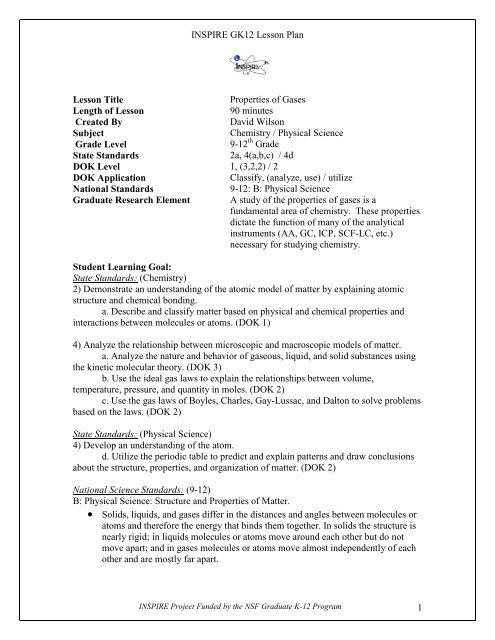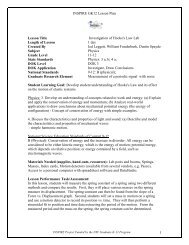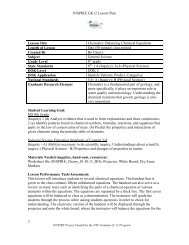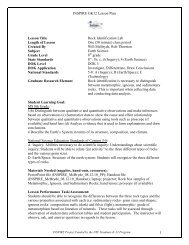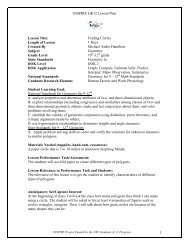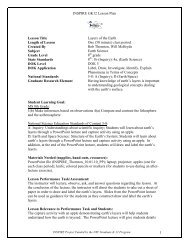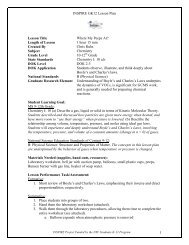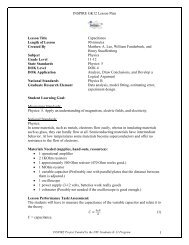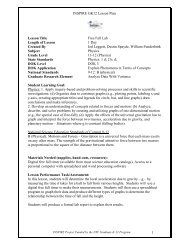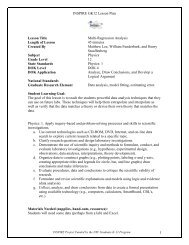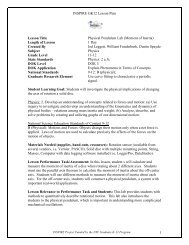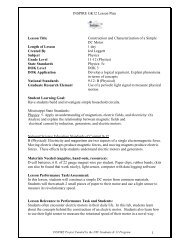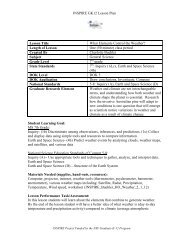Properties of Gases
Properties of Gases
Properties of Gases
You also want an ePaper? Increase the reach of your titles
YUMPU automatically turns print PDFs into web optimized ePapers that Google loves.
INSPIRE GK12 Lesson Plan<br />
Lesson Title<br />
<strong>Properties</strong> <strong>of</strong> <strong>Gases</strong><br />
Length <strong>of</strong> Lesson<br />
90 minutes<br />
Created By<br />
David Wilson<br />
Subject<br />
Chemistry / Physical Science<br />
Grade Level<br />
9-12 th Grade<br />
State Standards<br />
2a, 4(a,b,c) / 4d<br />
DOK Level 1, (3,2,2) / 2<br />
DOK Application<br />
Classify, (analyze, use) / utilize<br />
National Standards<br />
9-12: B: Physical Science<br />
Graduate Research Element A study <strong>of</strong> the properties <strong>of</strong> gases is a<br />
fundamental area <strong>of</strong> chemistry. These properties<br />
dictate the function <strong>of</strong> many <strong>of</strong> the analytical<br />
instruments (AA, GC, ICP, SCF-LC, etc.)<br />
necessary for studying chemistry.<br />
Student Learning Goal:<br />
State Standards: (Chemistry)<br />
2) Demonstrate an understanding <strong>of</strong> the atomic model <strong>of</strong> matter by explaining atomic<br />
structure and chemical bonding.<br />
a. Describe and classify matter based on physical and chemical properties and<br />
interactions between molecules or atoms. (DOK 1)<br />
4) Analyze the relationship between microscopic and macroscopic models <strong>of</strong> matter.<br />
a. Analyze the nature and behavior <strong>of</strong> gaseous, liquid, and solid substances using<br />
the kinetic molecular theory. (DOK 3)<br />
b. Use the ideal gas laws to explain the relationships between volume,<br />
temperature, pressure, and quantity in moles. (DOK 2)<br />
c. Use the gas laws <strong>of</strong> Boyles, Charles, Gay-Lussac, and Dalton to solve problems<br />
based on the laws. (DOK 2)<br />
State Standards: (Physical Science)<br />
4) Develop an understanding <strong>of</strong> the atom.<br />
d. Utilize the periodic table to predict and explain patterns and draw conclusions<br />
about the structure, properties, and organization <strong>of</strong> matter. (DOK 2)<br />
National Science Standards: (9-12)<br />
B: Physical Science: Structure and <strong>Properties</strong> <strong>of</strong> Matter.<br />
Solids, liquids, and gases differ in the distances and angles between molecules or<br />
atoms and therefore the energy that binds them together. In solids the structure is<br />
nearly rigid; in liquids molecules or atoms move around each other but do not<br />
move apart; and in gases molecules or atoms move almost independently <strong>of</strong> each<br />
other and are mostly far apart.<br />
INSPIRE Project Funded by the NSF Graduate K-12 Program 1
INSPIRE GK12 Lesson Plan<br />
Materials Needed (supplies, hand-outs, resources):<br />
{WARNING: Please read the MSDS <strong>of</strong> any chemical before using it.}<br />
[Quantities <strong>of</strong> the following supplies listed are per each group.]<br />
DEMO 1 – Balloon in a Bottle<br />
1 balloon<br />
1 bottle (glass or plastic)<br />
DEMO 2 – Can Crusher<br />
1 aluminum can<br />
water<br />
hotplate<br />
pie pan<br />
DEMO 3 – 2 Magic Jars<br />
2 mason jars (with lids)<br />
5”x5” window screening<br />
water<br />
DEMO 4 – HCl and NH 3<br />
2, 50 mL beakers<br />
30 mL ammonia (NH 3 )<br />
30 mL concentrated hydrochloric acid (HCl)<br />
Parafilm<br />
DEMO 5 – Explosive Reaction #1<br />
8 grams ammonium nitrate (finely, freshly ground)<br />
8 grams zinc powder<br />
1 gram ammonium chloride<br />
ceramic tile<br />
glass petri dish<br />
DEMO 6 – Explosive Reaction #2<br />
5 grams iodine<br />
50 mL concentrated ammonia<br />
filter paper<br />
DEMO 7 – Cartesian Diver (quantities per each student)<br />
1, 20 oz plastic bottle <strong>of</strong> water<br />
1 plastic transfer pipette<br />
1 hex nut (sized so that it fits very snuggly onto the pipette stem)<br />
OPTIONAL:<br />
o Hot glue and hot glue gun<br />
o Food coloring<br />
{See the Teachers Notes at the end <strong>of</strong> the lesson plan for directions.}<br />
Lesson Performance Task/Assessment:<br />
1) Students will describe and explain the demonstrations shown them in terms <strong>of</strong><br />
force <strong>of</strong> pressure, air pressure, and temperature.<br />
INSPIRE Project Funded by the NSF Graduate K-12 Program 2
INSPIRE GK12 Lesson Plan<br />
2) Students will relate the demonstrations to the properties <strong>of</strong> gases and gas laws,<br />
which they have learned previously.<br />
Lesson Relevance to Performance Task and Students:<br />
The students have learned to interpret descriptions <strong>of</strong> the properties <strong>of</strong> gases. They have<br />
learned also to perform calculations associated with the gas laws. In this lesson they will<br />
observe the practical implications <strong>of</strong> the descriptions <strong>of</strong> the properties <strong>of</strong> gases with they<br />
have learned.<br />
Anticipatory Set/Capture Interest:<br />
The students will be reminded <strong>of</strong> the gas properties that they have learned thus far, and<br />
the first demonstration will effectively motivate the students in the lesson. Each<br />
demonstration is rather dramatic.<br />
Guided Practice:<br />
As a class, each demonstration will be discussed without my giving the students a<br />
concrete explanation <strong>of</strong> the properties. The students’ thinking will be probed and guided<br />
with each demonstration.<br />
Independent Practice:<br />
Students will create their own Cartesian diver after being shown a completed one. They<br />
will have to construct it on their own. {See the Teachers Notes at the end <strong>of</strong> the lesson<br />
plan for directions.}<br />
Remediation and/or Enrichment:<br />
Remediation: Individual IEP.<br />
Enrichment: The students will relate the Cartesian diver to the concept <strong>of</strong> buoyancy and<br />
the construction <strong>of</strong> submarines.<br />
Check(s) for Understanding:<br />
Class discussions and students’ written explanations will be used to evaluate students’<br />
understanding.<br />
Closure:<br />
Students will explain each demonstration orally as a class.<br />
Possible Alternate Subject Integrations:<br />
This lesson is purely physical science.<br />
Teacher Notes:<br />
Instructions:<br />
1) Balloon in a bottle<br />
a. http://youtu.be/Rcnv0gGYup8 - - First demo in this video.<br />
INSPIRE Project Funded by the NSF Graduate K-12 Program 3
INSPIRE GK12 Lesson Plan<br />
b. Extension: Tell the volunteer you’ll pay them $50 if they can blow it up.<br />
They won’t be able to. Ask them if they’ll pay you $50 if you can blow it<br />
up. If they say yes, squeeze the bottle until the balloon pops out and<br />
inflates.<br />
2) Can Crusher<br />
a. http://youtu.be/Rcnv0gGYup8 - - Third demo in this video at 1:20 min.<br />
3) 2 Magic Jars<br />
a. http://www.wonderhowto.com/how-to-do-floating-water-trick-162796/<br />
4) HCl and NH 3<br />
a. http://youtu.be/qdQ62Z5Io1g - - First demo on this video.<br />
5) Explosive Reaction #1<br />
a. WATCH THESE BEFORE DOING THE REACTION!<br />
i. http://youtu.be/XFR1VeDOKs8<br />
ii. http://youtu.be/E5iBZdEIg8Y<br />
iii. The reactions are more violent than they appear in the video.<br />
6) Explosive Reaction #2<br />
a. WATCH THESE BEFORE DOING THE REACTION!<br />
i. http://youtu.be/L436Rx42jXg<br />
1. Notes: No filtration is necessary. Just spoon out the solid<br />
after the reaction, and spread it on filter paper to let it dry<br />
undisturbed.<br />
2. As long as it is wet it is not explosive. When it dries, it is<br />
explosive.<br />
ii. Classic Video: http://youtu.be/2KlAf936E90<br />
7) Cartesian Diver<br />
a. Detailed Reference with videos:<br />
http://dwb4.unl.edu/chemistry/beckerdemos/BD031.html<br />
b. Alternative Method with straws: http://youtu.be/BiI7DhFgoNQ<br />
INSPIRE Project Funded by the NSF Graduate K-12 Program 4


